Dr. Ken Otter
Professor & Chair
Dept of Ecosystem Science & Management
Natural Resources and Environmental Studies
University of Northern BC
3333 University Way, Prince George, BC, Canada, V2N 4Z9
phone (250) 960 5019
fax (250) 960 5539
email ken.otter@unbc.ca
(please note - due to workload and current commitments, I am not considering new graduate applications at the present time)
Congratulations to Sara Chartier and Cara Snell for succesfully defending their MSc theses in summer 2021!
RESEARCH
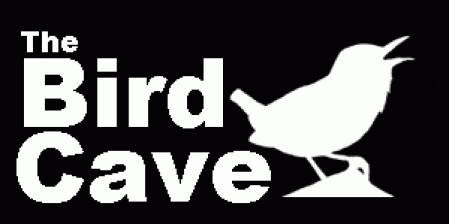 Officialy, we are the Avian Behaviour & Conservation Research Lab, but almost everyone refers to it as "The Bird Cave". This name came from the fact that we use to be housed in a windowless room in the basement that was rather cavernous. We have since moved to a windowed lab out of the basement, but the name (and logo) stuck.
Officialy, we are the Avian Behaviour & Conservation Research Lab, but almost everyone refers to it as "The Bird Cave". This name came from the fact that we use to be housed in a windowless room in the basement that was rather cavernous. We have since moved to a windowed lab out of the basement, but the name (and logo) stuck.
Our research centers on avian behavioural ecology, particularly in avian settlement, reproduction and communication are affected by habitat change. Our work with chickadees assesses the impact of habitat disturbance and urbanization on the normal breeding and communication behaviours of animals. Since 2013, much of this work is focusing a joint research project between Dr. Matt Reudink's (Thompson Rivers University) and our lab on mountain chickadees breeding on the urban interface in Kamloops, BC.
A second area of our work is looking at song evolution in white-throated sparrows (work being done with Scott Ramsay at Wilfrid Laurier University). We have been monitoring the spread of novel song variants (doublet-ending songs) across populations.
A new area we are starting to explore is how forestry practices like silviculture can affect the settlement and retention of avian species, which we are monitoring through autonymous recording units (ARU) at the John Prince Research Forest.
We are generally pretty collaborative, and have a number of ongoing projects with other labs working on overlapping themes, and this is something I actively encourage my students to get involved with - recent among these are the labs of Chris Sturdy (University of Alberta), Theresa Burg (University of Lethbridge), Scott Taylor (University of Colorado) and Hans Slabbekoorn (Leiden University).
So despite the logo, we haven't started on wrens yet (I just like this drawing and we figured Troglodytes troglodytes was a good species for a 'bird cave').
PEOPLE IN THE LAB
Cara began her Phd in September 2021 after completing her MSc on noise pollution and dawn singing behaviour in Mountain chickadees. Her PhD work will be focusing on comparing avian and small mammal biodiversity in natural (forest fire) vs silvicultural treatment disturbance patches.
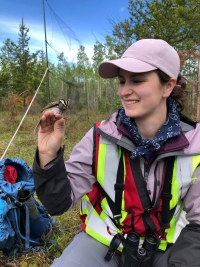
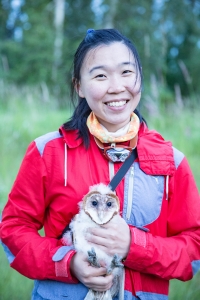
Alexandra Lamberton, MSc Student (Co-supervised with Matt Reudink, TRU)
Alexandra began her Masters in Sept 2018, and is investigating the impacts of urban vs rural environments on invertebrates, and how these impact nesting mountain chickadees. A major component of her work is investigating the difference of ectoparasite levels in urban vs rural chickadee nests, but she is also looking at differences in insect prey in nestling feeding.

Madison Oud, MSc Student (Co-supervised with Matt Reudink, TRU)
Madi has worked as a research assistant on the mountain chickadee project since 2019, and decided to continue on to pursue an MSc. She will be monitoring feeding behaviour in urban/rural settings using Radio-frequency Identifiers/PIT tags mounted on nesting mountain chickadees, modifying technology we have previously use for tracking movement in birds.
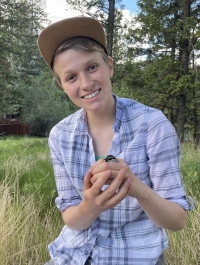
Kelsey Facca, BSc Honours Student
Kelsey started in the lab as a research assistant for our white-throated sparrow project in spring 2021, and decided to stick with the project for her honours thesis. She will be an analyzing archival data set of white-throated sparrow recordings dating back to 2004 from Riding Mountain National Park, Manitoba to look at the passage of different song variants through this population over time.
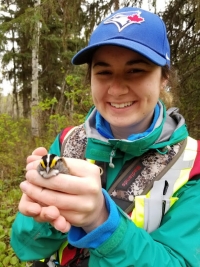
Amber Watts, BSc Honours Student
Amber worked as a research assistant in the summer of 2021 with Delta Marsh in Manitoba monitoring duck nests in the marshlands. She is using data she collected on interspecific brood parasitism of Canvasback nests by Redheads to see whether egg dumping rates relate to relative presence of Redheads in Canvasback ponds.
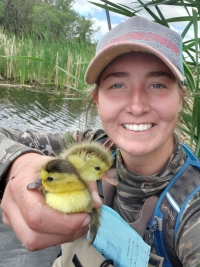
Former Birdcavers
Cara Snell (MSc 2021) - Avian communication networks: how audible are mountain chickadee males during dawn signalling? MSc. Thesis, University of Northern BC
Sara Chartier (MSc 2021) - Re-inventing an old hit: song evolution within and between Populations of white-throated sparrows. MSc. Thesis, University of Northern BC
Lauren Runge (BSc Thesis 2019) - Biodiversity and species composition between hardwood retention forest treatments. B.Sc. Thesis, University of Northern BC
Blaire Smith (BSc Thesis 2019) - Comparing anti-predator behaviour between urban and rural mountain chickadees. B.Sc. Thesis, University of Northern BC
Stefanie LaZerte (Postdoctoral Fellow 2015-2017) - Tracking avian movement movement patterns with RFID - the Animal Nexus Project (www.animalnexus.ca).
Erica Bonderud (MSc 2017) - Sex and the city: effects of individual condition and habitat urbanization on mountain chickadee reproductive behaviour. MSc. Thesis, University of Northern BC (co-supervised with Matt Reudink).
Jacob Bailey (MSc 2017) - Why did the chickadee cross the road: effects of linear habitat gaps on the movements of black-capped chickadees. MSc. Thesis, University of Northern BC (co-supervised with Matt Reudink).
Kristen Marini (MSc 2016) - City life and chickadees: effects of urbanization on vocal output and reproductive success of the mountain chickadee. MSc. Thesis, Thompson Rivers University (co-supervised with Matt Reudink).
Alexandra (Alex) Mckenna (BSc Thesis 2017) - Geographic evolution of the white-throated sparrow dialect. B.Sc. Thesis, University of Northern BC
Paul Koch (BSc Thesis 2017) - The influence of genetics on neophobia: responses of wolves, wolfdogs and dogs to visual stimuli. B.Sc. Thesis, University of Northern BC
Stefanie LaZerte (PhD 2015) - Sounds of the city: the effects of urbanization and noise on mountain and black-capped chickadee communication. PhD Thesis, University of Northern BC.
Hannah Zimmerman (BSc Thesis 2015) - Cultural evolution in white-throated sparrow song: regional variation through shift in terminal strophe type and length. B.Sc. Thesis, University of Northern BC
Isobel Hartley, Research Associate 2008-2014. Developing techniques for tracking bird movement patterns. www.unbc.ca/avian-movement
Angelique Grava (PhD 2012) -Interspecific interactions between mountain and black-capped chickadees within a contact zone. PhD Thesis, University of Northern BC.
Thibault Grava (PhD 2012) - Effect of habitat quality on communication and signalling in the black-capped chickadee. PhD Thesis, University of Northern BC.
Dustin Walsh (BSc Thesis 2011) - Nightvision monitoring of avian movement around wind farms. B.Sc. Thesis, University of Northern BC
Naira Johnston (MSc 2011, Research Associate 2012) - The associations between weather and topography on golden eagle flight behaviour at a wind farm in the Canadian Rockies. MSc. Thesis, University of Northern BC.
Katrina Wohlfarth (BSc. 2011) - The relationship between dominance and personality traits in chickadees. Independent Research Project. University of Northern BC
Laura Kennedy (BSc. 2011) - Relationship between grasshopper availability and crow movement patterns at the Prince George Airport. Independent Research Project. University of Northern BC
Andrea Pomeroy. (Postdoctoral Fellow 2007- 2009) - The use of metabolic assays to determine the indirect affect of wind development on migratory birds. NSERC Industrial Research and Development Fellow.
Sarina Loots. (Science Horizons Research Internship – Sept 2010-March 2011) - Development and testing of remote radars and radar tracking software (radR) for use in Avian Tracking at airports.
James Bradley (Research Associate - April 2009 – May 2012 part time) - Spatial movement of golden eagle migration in relation to weather patterns.
Regis Didier (Research Associate April to July 2009, April to July 2010) - Environmental effects on chickadee reproduction and food availability.
Veronica Mesias (Research Associate May to Sept 2009 (co-supervised with B. Murray) - Geographic variation in song dialects of white-throated sparrows in relation to genetic differentiation of migratory routes
Adrienne Labrosse (M.Sc. 2008) - Determining factors affecting carcass removal and searching efficiency during the post-construction monitoring of wind farms. MSc. Thesis, University of Northern BC.
Philippe Thomas (M.Sc. 2008) - Factors influencing avian movement patterns around proposed ridgeline wind farm sites in British Columbia, Canada. MSc. Thesis, University of Northern BC.
Laura Radigan (BSc. 2009) - Vegetation Trials and Bird Distribution Patterns at the Prince George Airport. USRA Project Student, University of Northern BC
Morgan Anderson (BSc. 2008) - Spatial and temporal patterns of avian movement around airports. USRA Project Student, University of Northern BC
Jeannine McCormack. (BSc. 2006) - Risk taking behaviour and winter foraging in chickadees – the effect of habitat. Independent Research Project. University of Northern BC.
Sarah Atherton. (BSc. 2005) - . The effect of urban lighting on dawn singing in chickadees. USRA Project Student 2004 and 2005, University of Northern BC
Eileen Brunsch (BSc. 2005) - Developing microsatellite techniques for black-capped chickadees. NSERC USRA project student 2004, and research assistant 2005/2006, University of Northern BC
Mark Keil (BSc. 2005) - The effects of windfarms on birds: a review. Independent Research Project. University of Northern BC.
Carmen Holschuh (M.Sc 2004) - Monitoring habitat quality and condition of Queen Charlotte saw-whet owls (Aegolius acadicus brooksi) using vocal individuality MSc. Thesis, University of Northern BC.
(BSc Thesis 2001) - Behavioural compensation for habitat induced differences in black-capped chickadee song transmission. B.Sc. Thesis, University of Northern BC
Harry van Oort (M.Sc 2004) - Habitat selection and impacts of habitat disturbance on somatic and reproductive investments in the black-capped chickadee. MSc. Thesis. University of Northern BC.
Tania Tripp (M.Sc. 2004) - Use of bioacoustics for population monitoring in the western screech-owl (Megascops kennicottii). MSc. Thesis, University of Northern BC.
Kevin Fort (M.Sc. 2003) - The effects of habitat disturbance on the reproductive behaviour of the black-capped chickadee (Poecile atricapilla).. MSc. Thesis, University of Northern BC.
Ingebjørg Jean Hansen (BSc Thesis 2003) - Communication breakdown: habitat influences on the communication networks and transmission of song in black-capped chickadee (Poecile atricapillus). B.Sc. Thesis, University of Northern BC
Zoe McDonell. (BSc Thesis 2002) - Feeding rates and nesting behaviour between disturbed and undisturbed woodlands in the black-capped chickadee. B.Sc. Thesis, University of Northern BC.
Kim Everett (BSc Thesis 2001) - The influence of wildlife tree management on cavity nesting birds in Northern BC. B.Sc. Thesis, University of Northern BC
PUBLICATIONS
- Otter, K.A., Reudink, M.W., Foote, J., McKellar, A. & Flood, N. 2021. Sexual selection and mating systems under Anthoprogenic disturbance. In: D. Proppe (ed). Songbird behavior: Implications for conservation and management in the Anthropocene, CRC Press. In press.
- Smith, B.L., Snell, C.L., Reudink, M.W. & Otter, K.A. 2021. Reduced response to simulated predators in urban-nesting mountain chickadees. Behaviour . DOI:10.1163/1568539X-bja10122
- Reudink, M.W., Fisher, M., Mount, N., Buckler, N., Otter, K.A, & Briskie, J.V. 2021. Evolution of song and colour in island birds. Wilson Journal of Ornithology In Press – accepted 17 April 2021.
- Graham, B., Gazeley, I., Otter, K.A. & Burg, T. 2021. Do phylogeny and habitat influence admixture among four North American chickadees (family: Paridae) species? Journal of Avian Biology. In press – accepted 4 Mar 2021.
- Stephens, C., McAmmond, B., Van Hamme, J.D., Otter, K.A., Reudink, M.W., Bottos, E.M. 2021. Analysis of Mountain Chickadee (Poecile gambeli) associated bacterial communities across urban and rural habitats. Canadian Journal of Microbiology In press – accepted 24 Jan 2021.
- Otter, K.A., Mckenna, A., LaZerte, S.E., & Ramsay, S.M. 2020. Continent-wide shifts in song dialects of white-throated sparrows. Current Biology 30(16): 3231-3235.e3 DOI:10.1016/jcub.2020.05.084
- Hajdasz, A.C., Otter, K.A., Baldwin, L.K., & Reudink, M.W. 2019. Caterpillar phenology predicts differences in timing of mountain chickadee breeding in urban and rural habitats. Urban Ecosystems 22:1113-1122.
- LaZerte, S.E., Slabbekoorn, H, & Otter, K.A. 2019. A field test of the audibility of urban versus rural songs in mountain chickadees. Ethology. 125:516–525. DOI: 10.1111/eth.12876
- Bailey, J.M., Reudink, M.W. & Otter, K.A. 2019. Supplemental feeding may reduce responsiveness of black-capped chickadees (Poecile atricapillus) to avian mobbing calls during gap-crossing experiments. Canadian Journal of Zoology 97: 680–684 DOI: 10.1139/cjz-2018-0161
- LaZerte, S.E., Marini, K.L.D, Slabbekoorn, H., Reudink, M.W., & Otter, K.A. 2019. More mountain chickadees sing atypical songs in urban than in rural areas. Canadian Field-Naturalist. 133(1): 28-33. DOI: 10.22621/cfn.v133i1.1994
- Bonderud, E.S., Otter, K.A., Burg, T.M., Marini, K.L.D. & Reudink, M.W. 2018. Patterns of extra-pair paternity in the mountain chickadee. Ethology 124: 378-386
- Bailey, J.M., Reudink, M.W., LaZerte, S.E., Paetkau, M., Johnson, C., Hill, D. & Otter, K.A. 2018. Using radio frequency identification (RFID) to investigate the gap-crossing decisions of black-capped chickadees (Poecile atricapillus). Auk: Ornithological Advances. 135:449-460
- Marini, K.L.D, Reudink, M.W., LaZerte, S.E. & Otter, K.A. 2017b. Urban mountain chickadees (Poecile gambeli) begin vocalizing earlier, and have greater dawn chorus output than rural males . Behaviour 154: 1197 – 1214. DOI:10.1163/1568539X-00003464
- Bonderud, E.S., Otter, K.A., Murray, B.W., Marini, K.L.D., Burg, T.M. & Reudink, M.W. 2017. Effects of parental condition and nesting habitat on sex allocation in the mountain chickadee. Behaviour 154: 1101 – 1121. DOI:10.1163/1568539X-00003460
- d'Entremont, M.V., Hartley, MI. & Otter, K.A. 2017. Comparing pre- versus post-operational movement of nocturnal migrants around a wind energy facility in northeast British Columbia, Canada. Avian Conservation and Ecology 12(2):3. https://doi.org/10.5751/ACE-01046-120203
- LaZerte, S.E., Reudink, M.W., Otter, K.A., Kusack, J., Bailey, J., Paetkau, M, De Jong, A., & Hill, D.J. 2017c. feedr and animalnexus.ca: A paired R package and user-friendly web application for transforming and visualizing animal movement data from static stations. Ecology and Evolution 7: 7884–7896. Doi:10.1002/ece3.3240
- Marini, K.L.D, Otter, K.A., LaZerte, S.E. & Reudink, M.W. 2017. Urban environments are associated with earlier clutches and faster nestling feather growth compared to natural habitats. Urban Ecosystems. 20: 1291-1300. DOI 10.1007/s11252-017-0681-2
- LaZerte, S., Slabbekoorn, H. & Otter, K.A. 2017. Territorial black-capped chickadee males respond faster to high- than to low-frequency songs in experimentally elevated noise conditions. PeerJ 5:e3257; DOI 10.7717/peerj.3257
- LaZerte, S., Otter, K.A., & Slabbekoorn, H. 2017. Mountain chickadees adjust songs, calls and chorus composition with increasing ambient and experimental noise. Ecosystems 20(5): 989-1000. DOI 10.1007/s11252-017-0652-7
- Hahn, A.H., Guillette, L.M, Hoeschele, M., Otter, K.A, Ratcliffe, L.M., & Sturdy, C.B. 2017. Discrimination of male black-capped chickadee songs: Relationship between acoustic preference and performance accuracy. Animal Behaviour 126: 107–121.
- Snell, C.L., LaZerte, S.E., Reudink, M.W. & Otter, K.A. 2016. Sympatric song variant in mountain chickadees Poecile gambeli does not reduce aggression from black-capped chickadees Poecile atricapillus. European Journal of Ecology. 2(1): x-x, doi: 10.1515/eje-2016-0006
- Zimmerman, H.D., Ramsay, S.M., Mesias, V., Mora, M., Murray, B. & Otter, K.A. 2016. Evolution in white-throated sparrow song: regional variation through shift in terminal strophe type and length. Behaviour 153: 1839–1861. [Chosen as COVER PHOTO for issue]
- LaZerte, S.E., Slabbekoorn, H. & Otter, K.A. 2016. Learning to cope: vocal adjustment to urban noise is correlated with prior experience in black-capped chickadees. Proceedings of the Royal Society of London B. 283: 20161058. http://dx.doi.org/10.1098/rspb.2016.1058
- Adams, R.V., LaZerte, S.E., Otter, K.A. & Burg, T.M. 2016. Influence of landscape features on the micro geographic genetic structure of a resident songbird. Heredity. 117: 63-72. link
- Hahn, A.H., Hoeschele, M., Guillette, L.M., Hoang, J., McMillan, N., Congdon, J.V., Campbell, K.A., Mennill, D.J., Otter, K.A., Grava, T., Ratcliffe, L.M., & Sturdy, C.B. 2016. Black-capped chickadees categorize songs based on geographic information. Animal Behaviour 112: 93–104.
- LaZerte, S.E., Slabbekoorn, H., & Otter, K.A. 2015. Sounds of the city: The effects of noise on communication in mountain and black-capped chickadees. Natural Resources & Environmental Studies Institute Research Extension Notes 10. University of Northern British Columbia. link
- LaZerte, S.E., Otter, K.A. & Slabbekoorn, H. 2015. Improving urban acoustics: Urban noise is more detrimental than urban habitat to transmission of chickadee vocalizations. Bioacoustics 24: 233 -252. link
- Ramsay, S.M. & Otter, K.A. 2015. Geographic variation in white-throated sparrow song may arise through epiphenomena selection. Journal of Ornithology 156:763–773.
- Kennedy, L. & Otter, K.A. 2015. Grass management regimes to mitigate bird-aircraft collisions; reducing grasshopper availability and subsequently American crow (Corvus brachyrhynchos) activity at airports. Human–Wildlife Interactions 9: 58–66
- Otter, K.A., Hartley, M.I., d’Entremont, M., Johnston, N.N., Walsh, D, Bradley, J., Willie M., & Pomeroy, A.C. 2014. Avian Movement at the Dokie 1 Wind Energy Project 2008-2012: analysis of potential conflict between wind development and avian migration in the northern Rocky Mountains. Natural Resources & Environmental Studies Institute (NRESi) Technical Report #1. University of Northern British Columbia. Prince George, B.C., Canada. (35 pages)
- Johnston, N.N., Bradley, J.E. & Otter, K.A. 2014. Increased flight altitudes may suggest turbine avoidance by migrating golden eagles at a Rocky mountain wind installation. Plos ONE 9(3): e93030
- Ainslie, B., Alexander, N., Johnston, N., Bradley, J., Pomeroy, A.C., Jackson, P.L., & Otter, K.A. 2014. Predicting spatial patterns of eagle migration using a mesoscale atmospheric model: a case study associated with a mountain-ridge wind development. International Journal of Biometeorology. 58: 17-30
- Johnston, N.N., Bradley, J.E., Pomeroy, A.C. & Otter, K.A. 2013. Flight paths of migrating Golden Eagles and the risk associated with wind energy development in the Rocky Mountains. Avian Conservation & Ecology 8(2): 12. http://dx.doi.org/10.5751/ACE-00608-080212
- Grava, T., Fairhurst G.D., Avey M.T., Grava A., Bradley J., Avis J.L., Bortolotti G.R, Sturdy C.B. & Otter K.A. 2013. Habitat quality affects early physiology and subsequent neuromotor development of juvenile black-capped chickadees. Plos ONE 8: e71852 (10 pages)
- Grava, T., Grava A. & Otter K.A. 2013. Habitat-induced changes in song consistency affect perception of social status in male chickadees. Behavioral Ecology & Sociobiology. 67:1699-1707
- Hahn, A.H., Guillet, L.M., Hoeschele, M., Mennill, D.J., Otter, K.A., Grava, T., Ratcliffe, L.M. & Sturdy, C.B. 2013. Dominance and geographic information contained within black-capped chickadee (Poecile atricapillus) song. Behaviour. 150: 1601-1622. DOI:10.1163/1568539X-00003111. (Article was highlighted with the cover photo for this issue of the journal)
- Grava, A., Otter, K.A Grava, T., & LaZerte, S. 2013. Character displacement in dawn chorusing behaviour of sympatric mountain and black-capped chickadees. Animal Behaviour 86: 177-187
- Grava, A., Grava, T., & Otter, K.A. 2012. Differential response to interspecific and intraspecific signals amongst chickadees. Ethology 118: 711–720.
- Grava, A., Grava, T, Didier, R., Lait, L., Koran, E., Dosso, J., Burg, T. & Otter, K.A. 2012. Interspecific dominance relationships and hybridization between black-capped and mountain chickadees. Behavioural Ecology 23: 566-572.
- Grava, T. Grava, A & Otter, K.A. 2012. Vocal performance varies with habitat quality in the black-capped chickadee. Behaviour 149 : 35–50.
- Otter, K.A., Murray, B.W., Holschuh, C.I. & Fort, K.T. 2011. Rare insights into intraspecific brood parasitism and apparent quasi-parasitism in black-capped chickadees. Animal Biodiversity & Conservation 34: 23-29
- Thomas, P.J., Labrosse, A.K, Pomeroy, A.C. & Otter, K.A. 2011. Effects of weather on avian migration at proposed ridgeline wind energy sites. Journal of Wildlife Management. 75: 805-815
- Lambrechts, M., Adriaensen, F., Ardia, D. R., Artemyev, A. V., Atiénzar, F., Bańbura, J., Barba, E., Bouvier, J.-C., Camprodon, J., Cooper, C. B., Dawson, R. D., Eens, M., Eeva, T., Faivre, B., Garamszegi, L. Z., Goodenough, A., Gosler, A., Grégoire, A., Griffith, S. C., Johnson, L. S., Kania, W., Keišs, O., Llambias, P. E., Mainwaring, M. C., Mänd, R., Massa, B., Mazgajski, T. D., Møller, A.P., Moreno, J., Naef-Daenzer, B., Nilsson, J.-Å., Norte, A. C., Otter, K. A., Park, C. R., Perrins, C. M., Pinowski, J., Porkert, J., Potti, J., Remes, V., Richner, H., Shiao, M.-T., Silverin, B., Slagsvold, T., Smith, H. G., Sorace, A., Stenning, M. J., Stewart, I., Thompson, C. F., Török, J., van Noordwijk, A. J., & Ziane, N. 2010. The design of artificial nestboxes for the study of secondary hole-nesting birds: a review of methodological inconsistencies and potential biases. Acta Ornithologica 45:1-26.
- Hoeschele, M. Moscicki, M.K., Otter, K.A., van Oort, H., Fort, K.T., Farrell, T.M., Lee, H., Robson, S.W.J. & Sturdy, C.J. 2010. Dominance signalled in an acoustic ornament. Animal Behaviour 79: 657–664
- Grava, T, Grava, A. & Otter, K.A. 2009. Supplemental feeding and dawn singing in black-capped chickadees. Condor 111: 560-564
- Schubert, K.A., Kraus, C., Mennill, D.J., Ramsay, S.M., Otter, K.A. & Ratcliffe, L.M. 2008. Enhanced annual survival of high ranking male black-capped chickadees: a multi-strata modelling approach. Auk 125: 629-636.
- Desrochers, A., Otter, K.A., Belisle, M. & Olson, J. 2007. Synopsis – Landscape ecology, conservation issues and behaviour. In. Otter, K. A. ed. Ecology and behavior of chickadees and titmice: an integrated approach. Pp. 293-298. Oxford University Press, Oxford.
- Mennill, D.J. & Otter, K.A. 2007. Status signaling and communication networks in chickadees: Complex communication with a simple song. In. Otter, K. A. ed. Ecology and behavior of chickadees and titmice: an integrated approach. Pp. 215-233. Oxford University Press, Oxford.
- Otter, K. A. ed. Ecology and behavior of chickadees and titmice: an integrated approach. Oxford University Press, Oxford.
- Otter, K.A., van Oort, H. and Fort, K.T. 2007. Habitat quality, reproduction and behaviour in chickadees and titmice: insights on the use of habitat matrixes in conservation? In. Otter, K. A. ed. Ecology and behavior of chickadees and titmice: an integrated approach. Pp. 277-298. Oxford University Press, Oxford.
- Otter, K.A., Atherton, S.E. & van Oort, H. 2007. Female food-solicitation calling, hunger levels and habitat differences in the black-capped chickadee. Animal Behaviour 74: 847-853
- Ramsay, S.M., & Otter, K.A. 2007. Seasonal variation in the timing of reproduction in titmice and chickadees. In. Otter, K. A. ed. Ecology and behavior of chickadees and titmice: an integrated approach. Pp. 55-69. Oxford University Press, Oxford.
- van Oort, H. Otter, K.A., Fort, K. & McDonell, Z. 2007. Habitat, dominance and the phenotypic quality of male black-capped chickadees. Condor 109: 88-96
- Schubert, K.A., Mennill, D.J., Ramsay, S.M., Otter, K.A., Boag, P.T. & Ratcliffe, L.M. 2007. Variation in social rank acquisition influences lifetime reproductive success in black-capped chickadees. Biological Journal of the Linnaean Society 90: 89-95
- Smulders, T.V., Lisi, M.D., Tricomi, E., Otter, K.A., Chruszcz, B., Ratcliffe, L.M., & DeVoogd, T.J. 2006. Failure to detect seasonal changes in the song system nuclei of the black-capped chickadee (Poecile atricapillus). Journal of Neurobiology 66: 991-1001
- Tripp, T. & Otter, K.A. 2006. Vocal individuality as a potential long-term monitoring tool for adult male Western Screech Owls. Canadian Journal of Zoology 84: 744-753
- van Oort, H., Otter, K.A., Fort, K. & Holschuh, C.I. 2006. Habitat quality, social dominance and dawn chorus song output in black-capped chickadees. Ethology 112:772-778
- Hansen, I.J., Otter, K.A. & van Oort, H. 2005. Communication breakdown? Habitat influences on the communication networks in black-capped chickadees. Acta Ethologica 8: 111-120
- Holschuh, C.I. & Otter K.A. 2005. Using vocal individuality to monitor Queen Charlotte Saw-whet Owls (Aegolius acadicus brooksi). Journal of Raptor Research 39:134-141
- van Oort, H. & Otter, K.A. 2005. Natal nutrition and habitat selection among juvenile black-capped chickadees. Canadian Journal of Zoology 83: 1495-1501
- Otter, K.A. & Ratcliffe, L. 2005. Enlightened decisions: female perspectives on communication networks. Pp. 133-151. In: Communication Networks (P.K. McGregor, ed). Cambridge University Press, Cambridge, UK.
- Everett, K.T. & Otter, K.A. 2004. Presence of cavities in snags retained in forest cutblocks: Do management policies promote species retention? Canadian Field Naturalist 118: 354-359
- Fort, K. & Otter, K.A. 2004a. Effects of habitat disturbance on reproduction in black-capped chickadees (Poecile atricapillus) in Northern British Columbia. Auk 121: 1070-1080
- Fort, K. & Otter, K.A.. 2004b. Territorial breakdown of black-capped chickadees, Poecile atricapillus, in disturbed habitats? Animal Behaviour 68:407-415
- Ramsay, S.M., Mennill, D., Otter K.A. & Ratcliffe, L.M.. 2003. Offspring sex ratio in relation to rank in the black-capped chickadee. Journal of Avian Biology 34:134-139
- Otter, K.A., Ratcliffe, L., Njegovan, M. & Fotheringham, J. 2002. The importance of frequency and temporal matching in aggressive vocal signalling of black-capped chickadees: evidence from interactive playback. Ethology 108: 181-191
- Otter, K., Stewart, I.K., McGregor, P.K., Terry, A.M.R., Dabelsteen, T. & Burke, T. 2001. Extra-pair paternity in great tits in relation to manipulation of male signals. Journal of Avian Biology 32: 338-344
- Doutrelant, C., Leitao, A., Otter, K. & Lambrechts, M.M. 2000. Interspecific competition and geographic song variation in the blue tit. Behavioral Ecology and Sociobiology 48: 119-124
- McGregor, P.K., Otter, K.A. & Peake, T.M. 2000. Communication networks: receiver and signaller perspectives. Pp. 361-372. In: Animal Signals. Adaptive Significance of Signalling and Signal Design in Animal Communication. (Y. Espmark, T. Amundsen & G. Rosenqvist, eds), Proc. Fifth Int. Kongsvoll Symp., September 15-20, 1998. Tapir Publishers, Trondheim, Norway.
- Peake, T.M., Otter, K., Terry, A.M.R., & McGregor, P.K. 2000. SCREECH: an interactive playback program for PCs. Bioacoustics. 11: 69-75
- Ramsay, S.M., Otter, K., Mennill, D.J. & Ratcliffe, L. 2000. Divorce & extrapair mating in female black-capped chickadees (Poecile atricapillus): separate strategies with a common target. Behavioral Ecology and Sociobiology 49: 18-23
- Otter, K., McGregor, P.K., Terry, A.M.R., Burford, F.R.L., Peake, T.M. & Dabelsteen, T. 1999. Do female great tits (Parus major) assess males by eavesdropping? A field study using interactive song playback. Proceedings of the Royal Society of London, Series B 266: 1305-1310
- Otter K., Ramsay, S.M. & Ratcliffe, L. 1999. Enhanced reproductive success of female black-capped chickadees mated to high ranking males. Auk 116: 345-354
- Otter, K. & Ratcliffe, L. 1999. Relationship of bib size to age and sex in the black-capped chickadee. Journal of Field Ornithology 70: 567-577
- Ramsay, S.M, Otter, K. & Ratcliffe, L.M. 1999. Nest site selection by female black-capped chickadees: settlement based on social attraction. Auk 116: 604-617
- Otter K., Ratcliffe, L., Michaud, D. & Boag, P.T. 1998. Do female black-capped chickadees prefer high ranking males as extra-pair partners? Behavioral Ecology and Sociobiology 43: 25-36
- Otter, K., Chruszcz, B. & Ratcliffe, L. 1997. Honest advertisement and singing during the dawn chorus of Black-capped Chickadees, Parus atricapillus. Behavioral Ecology 8: 167-173
- Otter, K. & Ratcliffe, L. 1996. Female initiated divorce in a monogamous songbird: abandoning mates for males of higher quality. Proc R Soc Lond 263: 351-354
- Otter, K. 1996. Individual variation in the advertisement call of male Saw-whet owls. J Field Ornithol 67: 398-405
- Ratcliffe, L. & Otter, K. 1996. Sex differences in song recognition. Pp. 339-355. In: Ecology and Evolution of Acoustic Communication among Birds. (D.E. Kroodsma & E.H. Miller, eds) Cornell University Press, Ithaca, New York
- Otter, K., Ratcliffe, L. & Boag, P.T. 1994. Extra-pair paternity in the black-capped chickadee. Condor 96: 218-222
- Otter, K., Njegovan, M., Naugler, C., Fotheringham, J. & Ratcliffe, L.. 1994. A simple technique for interactive playback experiments using a Macintosh Powerbook Computer. Bioacoustics 5: 303-310
- Otter, K. 1994. The impact of potential predation upon foraging behaviour of eastern chipmunks. Canadian Journal of Zoology 72: 1858-1861
- Otter, K. & Ratcliffe, L. 1993. Changes in the singing behaviour of male black-capped chickadees (Parus atricapillus) following mate removal. Behav Ecol Sociobiol 33: 409-414
